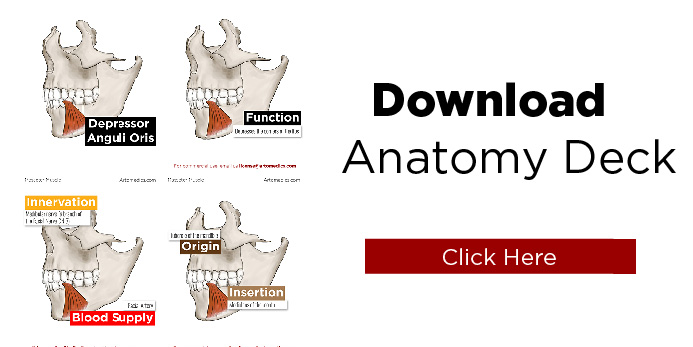Depressor Anguli Oris Muscle
Ever wondered who’s involved in making the sad emoji mouth happen? It’s the depressor anguli oris that pulls the corners of the mouth downwards, creating this universal expression of sadness emotion.

Depressor Anguli Oris facts
The depressor anguli oris muscle starts it’s journey from the mental tubercle in the mandible and travels below the depressor labii inferioris. It then joins narrowly and blends at the angle of the mouth with the orbicularis oris and risorius muscles. Additional fibers may continue blending into the levator anguli oris. Going down over the chin, it can blend some fibers with the platysma that covers the neck.
| Function | Depress the corners of the lips |
| Innervation | Madibular nerve (a branch of the Facial Nerve) |
| Blood supply | Facial artery |
| Origin (where it anchors) | Tubercle of the mandible |
| Insertion (what it moves) | Modiolous of the mouth |

What does the Depressor Anguli Oris Muscle do?
The depressor anguli oris (also called Triangularis or Triangularis Menti) pulls the angle of the mouth down and to the side (lateral) when you open the mouth and it works to express the classical face of sadness 🙁
When contracted, it creates the effect of curving the mouth downwards, making the nasolabial furrow somewhat flat and longer (aiding in creating the look of the long face when sad). It can make the mouth look wider and stretch the lips flat.
It can be involved in the expression of sadness, grief, depression, disgust, and sorrow.
Asymmetrical crying in babies
Congenital Hypoplasia of Depressor Anguli Oris Muscle is a rare disease some babies are born with (congenital). In this anomaly, the Depressor anguli oris muscle is underdeveloped (hypoplasia), which can be noted instantly when the baby is crying and only one side of the mouth is pulling down all the way as you’d normally expect, resulting in an asymmetric crying baby face.
References
Standring, Susan. Gray’s Anatomy: The Anatomical Basis of Clinical Practice. , 2016. Print.
Gupta R, Prasad PL. Congenital Hypoplasia of Depressor Angularis Oris Muscle. Med J Armed Forces India. 2009;65(2):188-189. doi:10.1016/S0377-1237(09)80146-9

Leave a Reply